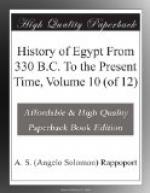Stilpo was at this time only on a visit to Ptolemy, for he had refused his offer of money and a professorship in the Museum, and had chosen to remain at Megara where he was the ornament of his birthplace. He had been banished from Athens for speaking against their gods, and for saying that the colossal Minerva was not the daughter of Jupiter, but of Phidias, the sculptor. His name as a philosopher stood so high that when Demetrius, in his late wars with Ptolemy, took the city of Megara by storm, the conqueror bid spare the house of Stilpo, when temple and tower went to the ground; and when Demetrius gave orders that Stilpo should be repaid for what he had lost in the siege, the philosopher proudly answered that he had lost nothing, and that he had no wealth but his learning.
The historian Theopompus of Chios then came to Alexandria, and wrote an account of the wars between the Egyptians and the Persians. It is now lost, but it contained at least the events from the successful invasion by Artaxerxes Longimanus till the unsuccessful invasion by Artaxerxes Mnemon.
No men of learning in Alexandria were more famous than the physicians. Erasistratus of Cos had the credit of having once cured Antiochus, afterwards King of Syria. He was the grandson of Aristotle, and may be called the father of the science of anatomy: his writings are often quoted by Dioscorides. Antiochus in his youth had fallen deeply in love with his young stepmother, and was pining away in silence and despair. Erasistratus found out the cause of his illness, which was straightway cured by Seleucus giving up his wife to his own son. This act strongly points out the changed opinions of the world as to the matrimonial relation; for it was then thought the father’s best title to the name of Nicator; he had before conquered his enemies, but he then conquered himself.
Erasistratus was the first who thought that a knowledge of anatomy should be made a part of the healing art. Before his time surgery and medicine had been deemed one and the same; they had both been studied by the slow and uncertain steps of experience, unguided by theory. Many a man who had been ill, whether through disease or wound, and had regained his health, thought it his duty to Esculapius and to his neighbours to write up in the temple of the god the nature of his ailings, and the simples to which he fancied that he owed his cure. By copying these loose but well-meant inscriptions of medical cases, Hippocrates had, a century earlier, laid the foundations of the science; but nothing further was added to it till Erasistratus, setting at nought the prejudices in which he was born, began dissecting the human body in the schools of Alexandria. There the mixing together of Greeks and Egyptians had weakened those religious feelings of respect for the dead which are usually shocked by anatomy; and this study flourished from the low tone of the morality as much as from the encouragement which good sense should grant to every search for knowledge.




